Big Iran story? Not on MSNBC
- Share via
In recent days, much of the news media’s attention has been focused on post-election protests and violence in Iran. But at MSNBC, the crisis has taken on a bit less urgency, at least if viewers are to judge from what the network is airing.
Over the weekend, with its cable rivals devoting generous airtime to demonstrations convulsing Tehran and online viewers transfixed by amateur video of a young woman apparently felled by a sniper’s bullet, MSNBC stuck to its usual diet of taped documentaries, including one titled “Sex Slaves in America.” A rerun of the prison documentary “Lockup” aired Saturday night. Meanwhile, anchor Shepard Smith was giving viewers of Fox News Channel a special two-hour wrap-up of Iranian developments. CNN likewise devoted substantial blocks of time to covering the crisis live.
On the Web, MSNBC’s coverage decision generated some furious reactions. On Twitter, one user called the network “MIA”; another wrote, “MSNBC closed eyes to murder in Iran.” And the Huffington Post’s Tom D’Antoni blogged that MSNBC “disgraced themselves this weekend by ignoring the biggest story in the world.”
Thus came another difficult moment for MSNBC, a news network that has struggled for years to strike the right balance between covering breaking news and exploring more distinctive (and often cheaper) alternatives.
MSNBC has a precedent for giving short shrift to major stories that have erupted on weekends. In November, critics chafed when the network bailed on wall-to-wall coverage of the Mumbai terrorist standoff, which began on a Wednesday and did not end until Saturday. But executives have also proven they are willing to drop their usual plans in certain situations: On the weekend of April 12, when an American skipper was rescued from Somali pirates, MSNBC broke into its regular programming with live coverage.
For its part, the network defended its handling of the Iran crisis, saying it was ready to spring into action if the situation there escalated further.
“We were monitoring the situation closely and decided that we would cover the situation with hourly updates,” MSNBC spokesman Jeremy Gaines wrote in an e-mail response to questions. “We had an anchor and crew standing by.”
He also dismissed the suggestion that the coverage plans were dictated by financial considerations, although he did not provide specifics.
As for the taped shows, “these programs generate higher viewership for us on weekends” than other types of programming, Gaines added.
But given the intensity of the reaction elsewhere, MSNBC’s decision over the weekend struck many as puzzling.
“I was surprised they did not break into their air for Iran coverage,” said Marvin Kalb, a former CBS newsman and a senior fellow at the Joan Shorenstein Center at Harvard University. “It’s one of the great stories of our time, and something the American people need to know about.”
From its founding 13 years ago, taped fare has been a key part of MSNBC’s makeup. But since the network began experimenting with greater use of documentaries in 2006 (about 18 months ago, the taped shows started appearing from noon to 4 p.m. on weekends as well), the network has struggled to blend that programming with what it does at other hours. That includes breaking news coverage as well as the popular prime-time shows hosted by Keith Olbermann and Rachel Maddow, which have helped drive overall ratings gains in recent months. The juxtaposition has sometimes resulted in a hazy identity.
Phil Griffin, who last summer was tapped to be president of MSNBC, has in the past indicated a desire to at least tweak the taped format.
“I want our prime-time personalities to drive more of our documentaries,” Griffin told reporters in January.
Typically, the tape strategy poses few problems, as news tends to slow on the weekends anyway. But there has been nothing typical about the violence that has seized Iran, a country in flux since the disputed presidential election on June 12.
Saturday saw the protests reach a climax, with gory amateur video that purported to show the death of 26-year-old Neda Agha-Soltan ricocheting around the Web and into the mainstream media within hours.
While the MSNBC documentaries tend to do better than news coverage during non-crisis times, they are by no means huge ratings grabbers.
On Saturday, Fox News drew an average of 1.3 million total viewers for its Iran-heavy coverage, beating the combined totals of CNN (639,000) and MSNBC (359,000). Smith’s 8 p.m. hour averaged 1.5 million, making it the weekend’s most-watched cable news program, according to Nielsen Media Research.
Gaines pointed out, however, that MSNBC beat CNN among viewers aged 25 to 54, the most-favored demographic in the news business.
--
More to Read
The biggest entertainment stories
Get our big stories about Hollywood, film, television, music, arts, culture and more right in your inbox as soon as they publish.
You may occasionally receive promotional content from the Los Angeles Times.










